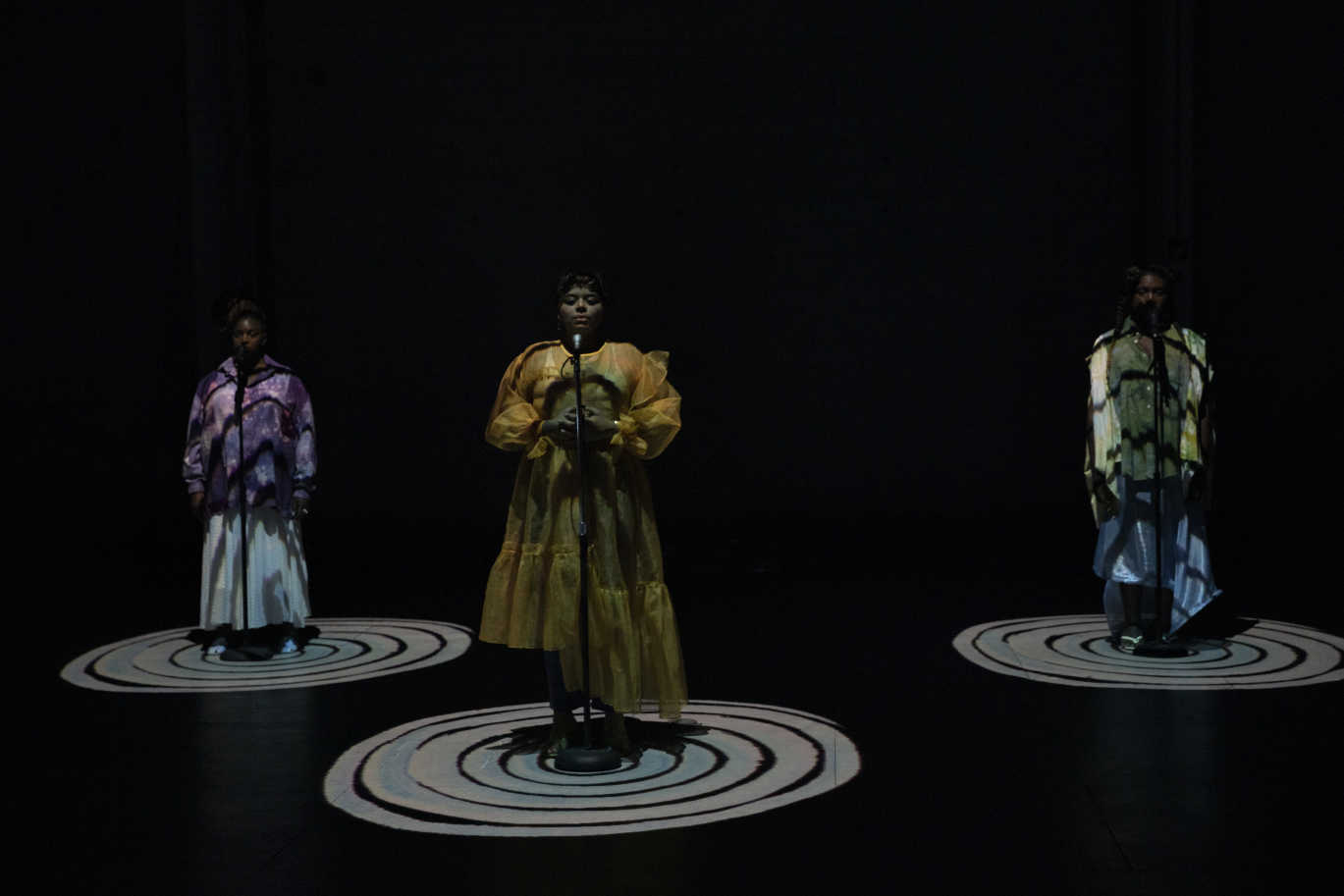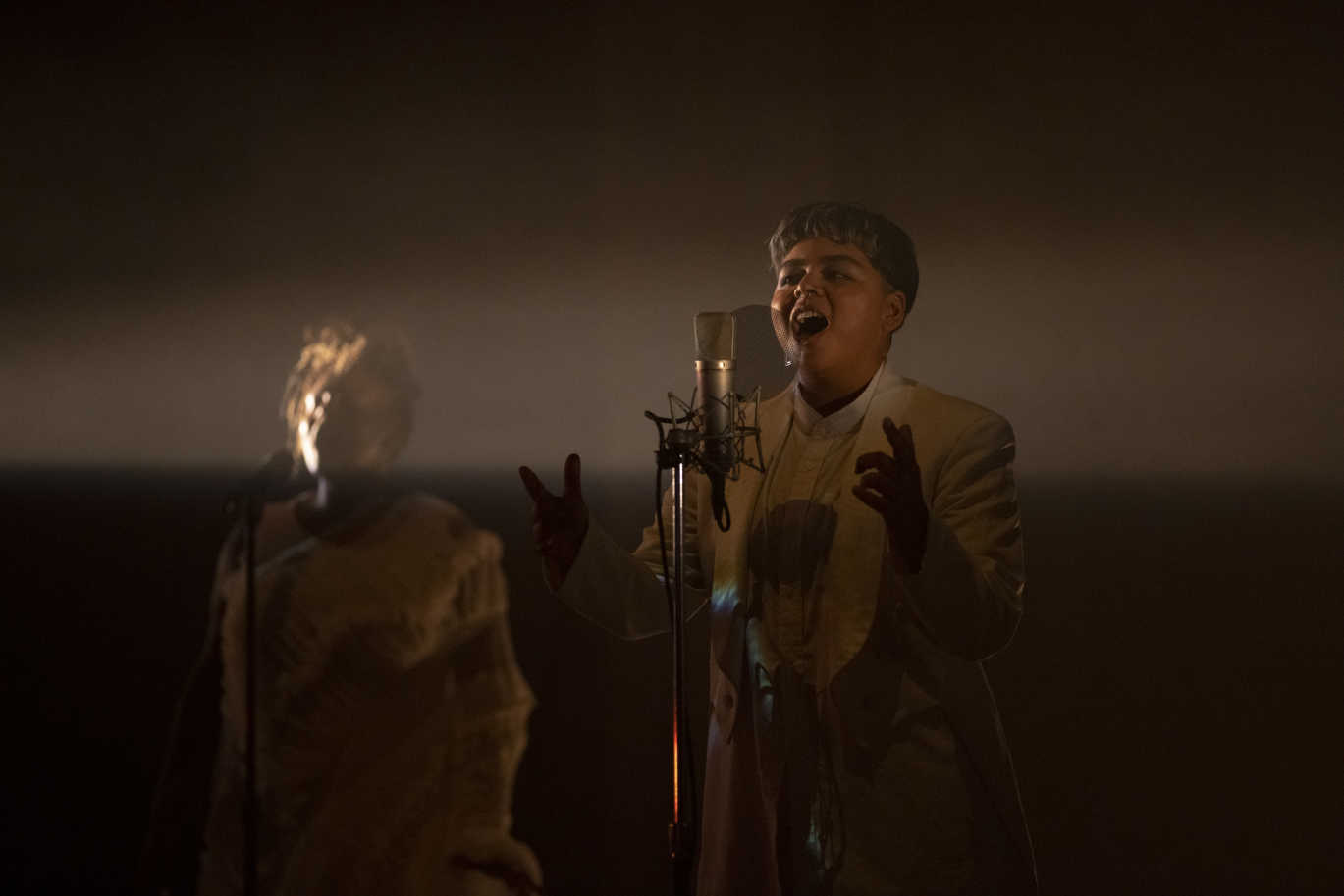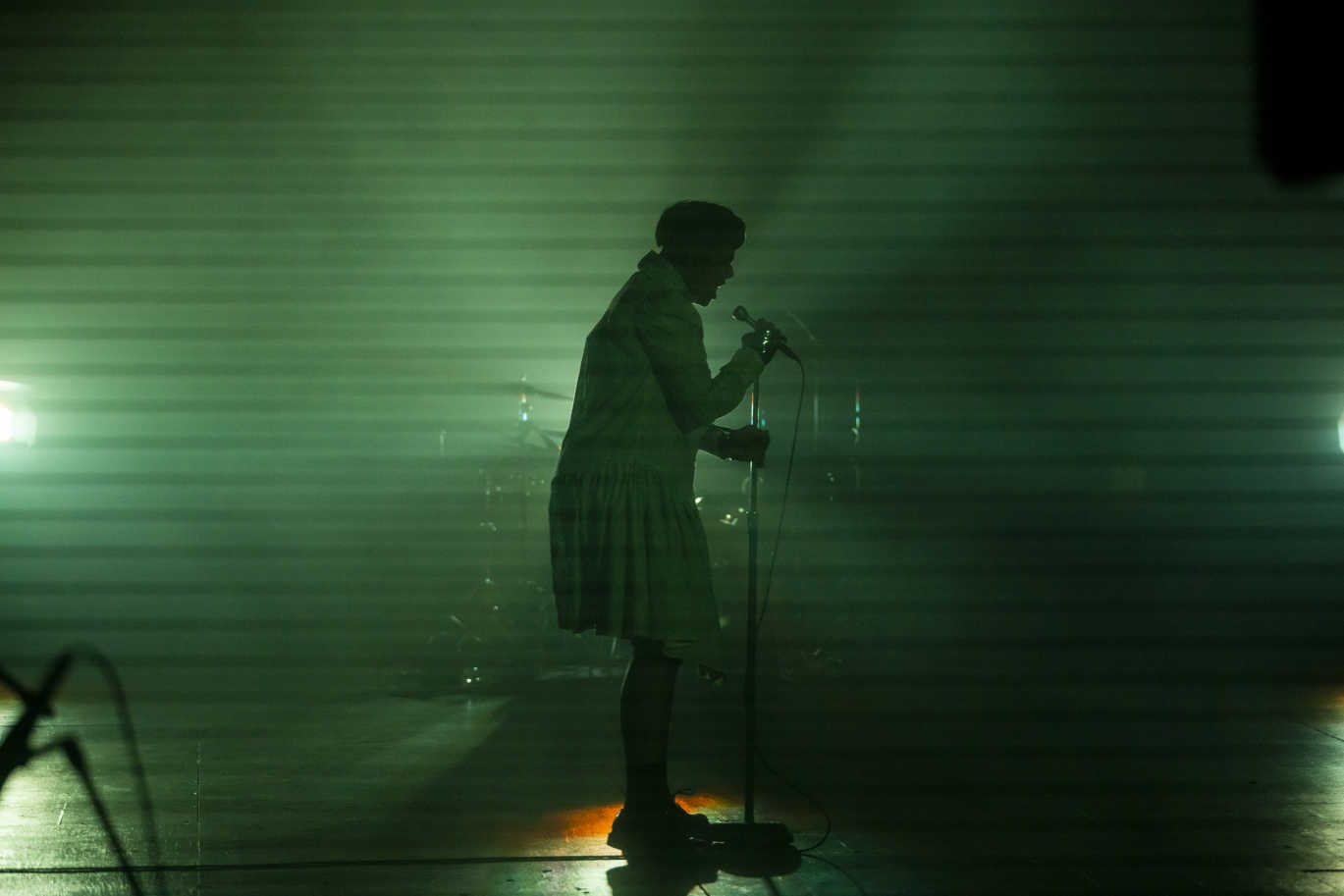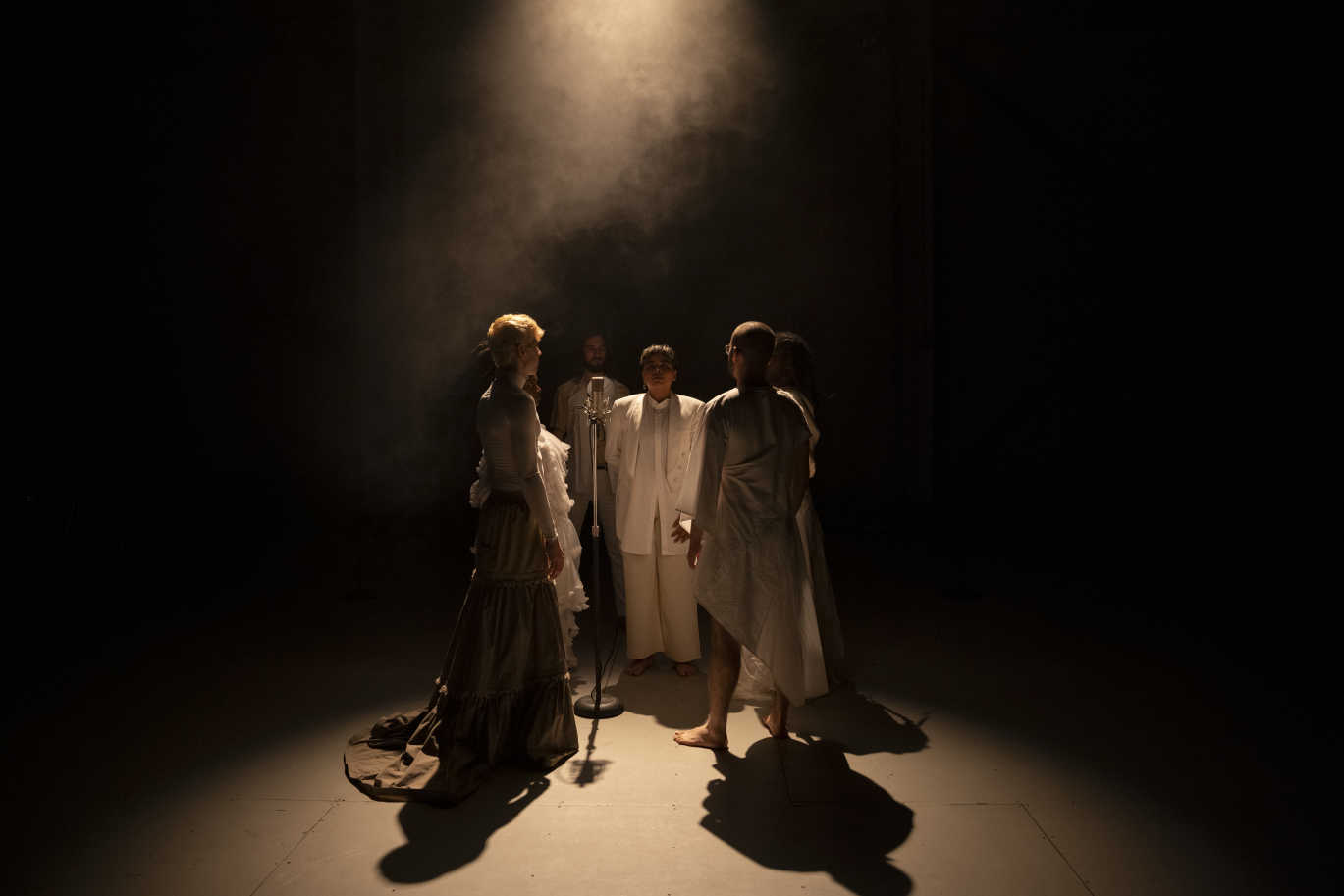
Credits:
By Maryam Rahaman, Summer 2021 Curatorial Intern and Sienna Fekete, 2021–2022 Curatorial Fellow
July 8, 2021
stefa marin alarcon was in residence through The Kitchen at Queenslab from May 17–23, 2021. The work that they created during their residency, Born With An Extra Rib: The Film, will premiere at The Kitchen on March 17, 2022.
After alarcon’s residency, Curatorial Intern Maryam Rahaman spoke with the artist about their work and process of creating Born With An Extra Rib: The Film. The transcript of the conversation appears below, edited for length and clarity by Curatorial Fellow Sienna Fekete.


Maryam Rahaman: Would you like to start off by discussing your relationship to art and what drew you to wanting to create?
stefa marin alarcon: Singing is the first thing for me and will be the last thing. Currently I'm thinking about the connection between my body and my art and how there really is no separation. I’m reevaluating what care looks like for me because if I don’t tend to my physical and spiritual wellbeing then what am I doing? How can I expect my art to expand and transform if I’m stagnant with my care? I come from a traditional form of studying the voice, body, breath, and connection to thought and action, and knowing the power of doing it with other people.
When I started writing my own music after fifteen years of training, I had really had it with singing “dead white man music.” After so many years of learning others’ music and stories, it felt like I couldn’t keep doing the same thing and expecting to feel fulfilled or challenged. When I wrote my first vocal composition, it felt like a reclamation of my voice and my histories. It was the most excited I’d felt about music probably in my entire life. It really felt like mine. I’m addicted to the feeling of experiencing art, theater, music with other people, and I have a desire to move and transform people and spaces.
__How does your present practice draw from and push against your background in classical voice, theater, and those early interests in using your voice? How has that changed or stayed the same? __
Classical music gave me such an important structure. Something like the voice being your instrument, a lot of it is really more conceptual. Whether you’re thinking about where you’re placing it, how to think about your breathing, how to listen to other voices so that you can sound like one voice breathing together silently. All of these things that classical music and being in theater taught me are about the interconnectedness of not just the people on stage with you or creating with you, but also your audience and how that experience is very sacred.
The sacredness is something that maybe when I was younger, I didn’t think of it that way. I thought of it as, “well, this is how we do it.” We have to do a good job. This is how we show up. This is how we warm up together. This is how we work on stage. It was still a ritual, but it was masked as “we’re performing.” The act has transformed for me because it feels intentionally connected to spirit. I’m bringing my ancestors and the weight of the work and the sacredness of the work and the stories that we’re telling into the spaces I perform in.
__How does your present practice draw from and push against your background in classical voice, theater, and those early interests in using your voice? How has that changed or stayed the same? __
Classical music gave me such an important structure. Something like the voice being your instrument, a lot of it is really more conceptual. Whether you’re thinking about where you’re placing it, how to think about your breathing, how to listen to other voices so that you can sound like one voice breathing together silently. All of these things that classical music and being in theater taught me are about the interconnectedness of not just the people on stage with you or creating with you, but also your audience and how that experience is very sacred.
The sacredness is something that maybe when I was younger, I didn’t think of it that way. I thought of it as, “well, this is how we do it.” We have to do a good job. This is how we show up. This is how we warm up together. This is how we work on stage. It was still a ritual, but it was masked as “we’re performing.” The act has transformed for me because it feels intentionally connected to spirit. I’m bringing my ancestors and the weight of the work and the sacredness of the work and the stories that we’re telling into the spaces I perform in.

The idea of there always being this ritual aspect—that’s a really interesting way of thinking about it. You draw from a lot of different genres and traditions in your music. How does this guide your work?
I feel like with these most recent songs and pieces that I put into Born With An Extra Rib: The Film came from feelings and came from questions. It wasn’t so much that I wanted to make a punk song or I wanted to make a choral, minimalist piece. It was more like, I want to understand this question or I want to understand this phrase deeper or why is this nagging at me? And then it came out in “Costillas” for example, which I always like to say is my punk redemption song, and that’s the energy! The energy of my performance, yes, but also what I’m talking about is destroy the binary and destroy the patriarchy and protect us. That feeling was there, so much exasperation and rage and beauty and ecstatic joy and all of those things together with the choral parts that are also very integral to my music-making. I think all those influences allow me to not need to push into a certain genre because I’d like to create things that are outside of that and that feels really exciting to me, to be genreless.
That is really exciting. It makes me wonder about what other musicians might say to the question of how and why I perform in this genre. How do collaborative processes inform, transform, or add to your work?
Collaborating with people is such a personal and vulnerable process. In my collaborations I’m so blessed because there is this mutual respect and care for each other and the work and transparency. That feels so important right now, and centering all those things in our collaborations because it’s also a reflection of how we’re treating ourselves. The people that I work with, I work with them because I know that they’re going to bring their perspective and their vision that sometimes I can’t see on my own. I might be creating these loops or maybe creating these pieces, compositions, videos, but like these ideas, I need a team to expand the vision together and when they bring their full selves and if the relationship is cared for then the collaboration is only that much more genuine. With Born With An Extra Rib: The Film, I worked with people who believe in the world so much that we were able to create a really intentional environment for everyone. The people I work with are virtuosos, they are just everything. I’m in awe of LILLETH who was my co-director and co-creative producer on this piece. Our collaboration started as friends and then grew into this desire of wanting to deepen that relationship. I’m thinking of bassist Nick Jozwiak and audio engineer Lily Wen, who I’ve been working with for four years. The way that these artists respect their practice and our relationships is the reason why we can create this magic together. There has to be a deep, mutual trust between who you work with.
That makes sense and sounds like a special way of thinking about collaboration. I love the idea that you’re expecting them to bring their own work. A true collaboration in that sense, rather than just “do my idea.” In thinking about collaboration and spaces of collaboration, how did the Queenslab space shape the direction of what you wanted to do during your residency?
When we came into Queenslab, we realized what the capacity of the space really was. We saw it as a theater we could build out to create this world that had multiple worlds within it. Kelley Shih, who was our lighting designer, LILLETH, and I were so excited to use Queenslab in the most expansive way possible and The Kitchen was like “yes let's do it!” We came in with really ambitious ideas of using the space as a theater, but also as a film set and also as a meeting place and also as a space to ground ourselves. We had space for an altar, space to cleanse ourselves after doing three takes of the same piece. We had to be prepared and open to the way that spirit was going to move through us because that was what the work called for and what the space was allowing us to do.
That makes sense and sounds like a special way of thinking about collaboration. I love the idea that you’re expecting them to bring their own work. A true collaboration in that sense, rather than just “do my idea.” In thinking about collaboration and spaces of collaboration, how did the Queenslab space shape the direction of what you wanted to do during your residency?
When we came into Queenslab, we realized what the capacity of the space really was. We saw it as a theater we could build out to create this world that had multiple worlds within it. Kelley Shih, who was our lighting designer, LILLETH, and I were so excited to use Queenslab in the most expansive way possible and The Kitchen was like “yes let's do it!” We came in with really ambitious ideas of using the space as a theater, but also as a film set and also as a meeting place and also as a space to ground ourselves. We had space for an altar, space to cleanse ourselves after doing three takes of the same piece. We had to be prepared and open to the way that spirit was going to move through us because that was what the work called for and what the space was allowing us to do.
I love the idea of thinking about how that’s part of The Kitchen’s whole aim, how the space can be used and utilized by the artist. Now that you’ve had a little bit of time to reflect on the process, how would you describe Born With An Extra Rib?
It feels evolving. It feels like it’s growing. I’m still asking myself many of these questions that are in the film. It's a witnessing of a portal that was opened for this group of people to heal. I used my body and I used my process of returning to my body, and listening to my body for the first time, truly, and hearing my body speak to me. That informed so much of the process and the film itself.
I love the idea of thinking about how that’s part of The Kitchen’s whole aim, how the space can be used and utilized by the artist. Now that you’ve had a little bit of time to reflect on the process, how would you describe Born With An Extra Rib?
It feels evolving. It feels like it’s growing. I’m still asking myself many of these questions that are in the film. It's a witnessing of a portal that was opened for this group of people to heal. I used my body and I used my process of returning to my body, and listening to my body for the first time, truly, and hearing my body speak to me. That informed so much of the process and the film itself.
__I know you said at first you were thinking about how you feel about the film. Would you like to talk about that now although it’s still evolving and progressing? __
I feel really excited about this piece and so grateful to The Kitchen. I’m really excited to expand not only my collaborations, but the forms that my art takes through this returning. I’m returning to the theater with Born With An Extra Rib! And in this returning, we’re able to make our own guidelines, we’re able to center new things that in maybe traditional theater spaces or art spaces aren’t valued like the care of the artist and the care of everyone in the space. With Born With An Extra Rib I’m creating a theater that includes and prioritizes queer, trans, Black, Brown, and Indigenous people and bodies and still makes space for all of our ancestors. And not just the ones whose language we’re singing. It’s like Born With An Extra Rib is the film and the record and the staged live performance, but it’s also just a new way of experiencing each other in space while we center all of those things.

__Right. I feel like it’s important to have that description but also have what you have learned or transformed. As the film draws upon a lot of different disciplinary approaches like theater and ritual and film, how did the structure of opera shape it? __
I love that this film has all of these different disciplines, and we’ve been calling it a transdisciplinary piece because of all of these structures or guidelines that we are messing with. We get to pull from whatever we want when we create a transdisciplinary piece, and we get to create our own genres and play with these genres that already exist and have not historically included Indigenous queer people. I love using the word opera when I describe this piece, as well as using ritual or concert or film because it is pushing against all of these words and the grandness of the piece and the voices that I am composing for are taking up space. I was excited to bring in my own history and relationship with opera and with classical voice because that was such a huge part of my life for so many years and seen as this epitome of “high art,” and yet it very much excluded people like me. This is a trans opera. We need more radical trans operas that are about returning to Earth and Body!
__Right. I feel like it’s important to have that description but also have what you have learned or transformed. As the film draws upon a lot of different disciplinary approaches like theater and ritual and film, how did the structure of opera shape it? __
I love that this film has all of these different disciplines, and we’ve been calling it a transdisciplinary piece because of all of these structures or guidelines that we are messing with. We get to pull from whatever we want when we create a transdisciplinary piece, and we get to create our own genres and play with these genres that already exist and have not historically included Indigenous queer people. I love using the word opera when I describe this piece, as well as using ritual or concert or film because it is pushing against all of these words and the grandness of the piece and the voices that I am composing for are taking up space. I was excited to bring in my own history and relationship with opera and with classical voice because that was such a huge part of my life for so many years and seen as this epitome of “high art,” and yet it very much excluded people like me. This is a trans opera. We need more radical trans operas that are about returning to Earth and Body!
__I love the idea of creating a space where people who aren’t heard get to take up that space. Especially as you said, in an art form like opera, which is “high art.” How do you imagine the work fitting into your journey and evolution as an artist? __
One of the most exciting things of this piece was the power of collaboration. In the theater you have these structures, you need the team to create and execute the vision. And so with Born With An Extra Rib: The Film, to be able to draw from a built-in network, these relationships I’ve been tending to, an interconnected team coming together to bring this performance piece to life felt very intuitive. It’s like I’m returning to this art form, but in a completely new way and with a new role and new responsibilities. It’s not just I’m creating for myself, but I’m also creating and thinking about other voices and other bodies on stage and what space they’re going to take up within the story and within the community of the creators. To bring all of these things that have been exciting me the last few years in my artistic journey, which is making music videos and making loops, and to bring that into a bigger space and a different form that’s bringing together all these intentions—it feels very natural to be moving towards these spaces where I can bring more of these forms together like concert, ritual, theater.
__That is really exciting. How might you draw on the film, the concert, or the opera in the future? __
The film is documentation of what happened in the space. We were calling in spirit guides. We were calling in ancestors. We were taking on the pain of our ancestors and we were taking on the joy as well as their resilience and their survival through us. All of those things we channeled through the music and through the movement and through the ritual performance of every piece, because we did it more than once. It really felt like a sustained performance ritual. All of the things that we were drawing on and calling into the space are still very present in all of our lives. It’s still these questions of, how do I listen to my body? How do I take care of myself? How do I keep fighting these powers while still remaining tender? How do I call in and care for the relationships with my ancestors? Through all these songs we got to ask those questions and so this film feels alive with that and also very vulnerable. It feels like a source, a place to continue to ask those questions and also maybe rejoice in the asking too.
__That is really exciting. How might you draw on the film, the concert, or the opera in the future? __
The film is documentation of what happened in the space. We were calling in spirit guides. We were calling in ancestors. We were taking on the pain of our ancestors and we were taking on the joy as well as their resilience and their survival through us. All of those things we channeled through the music and through the movement and through the ritual performance of every piece, because we did it more than once. It really felt like a sustained performance ritual. All of the things that we were drawing on and calling into the space are still very present in all of our lives. It’s still these questions of, how do I listen to my body? How do I take care of myself? How do I keep fighting these powers while still remaining tender? How do I call in and care for the relationships with my ancestors? Through all these songs we got to ask those questions and so this film feels alive with that and also very vulnerable. It feels like a source, a place to continue to ask those questions and also maybe rejoice in the asking too.
__Thank you so much. That was a really wonderful answer. Is there anything else you want to talk about? __
This film is hard to talk about, I will say, as stefa. It’s hard to talk about the content of this film because a lot of the music came from the idea of “Born With An Extra Rib,” which is born different, born seen as a threat, born within the binary, and my journey in accepting and stepping into my expansiveness, stepping into my transness in a very binary, violent world is still a process, but it's still so alive for me and so present. Creating this theater piece or creating this film or creating this ritual wasn’t just, “oh haha we’re taking up space, we’re doing it!” It was terrifying to say, “I woke up in the same body that I went to bed in last night, and I’m not sure I know myself.” I’m not sure I know who this person is anymore. I make work about my journey of liberation and the collective experience. At the core of it is accepting my truth, and hopefully creating an irresistible space where other people can accept their truths, too.
__That’s so beautiful. Especially the part in the film where you say something like, “I’m finally understanding who I am.” I thought, wow, that's such a beautiful sentiment. So thank you. It’s really scary to share that kind of vulnerable and transformative art. I hope everyone who watches it has that moment of, “wow, that’s a really wonderful thing.” Thank you for expressing that. __
Thank you! It felt important to share because I have to be honest with myself. It’s really close to me.
__Production Credits for Born With An Extra Rib: The Film: __ stefa marin alarcon | Creator / Composer / Co-Director / Co-Creative Producer; LILLETH | Co-Director / Choreographer / Co-Creative Producer; Nova Scott James + Flor Tejada | Filmmakers; Kelley Shih | Lighting Designer, Projection Coordinator; Lily Wen | Sound Engineer; Joseph Charles Viola | Stylist

